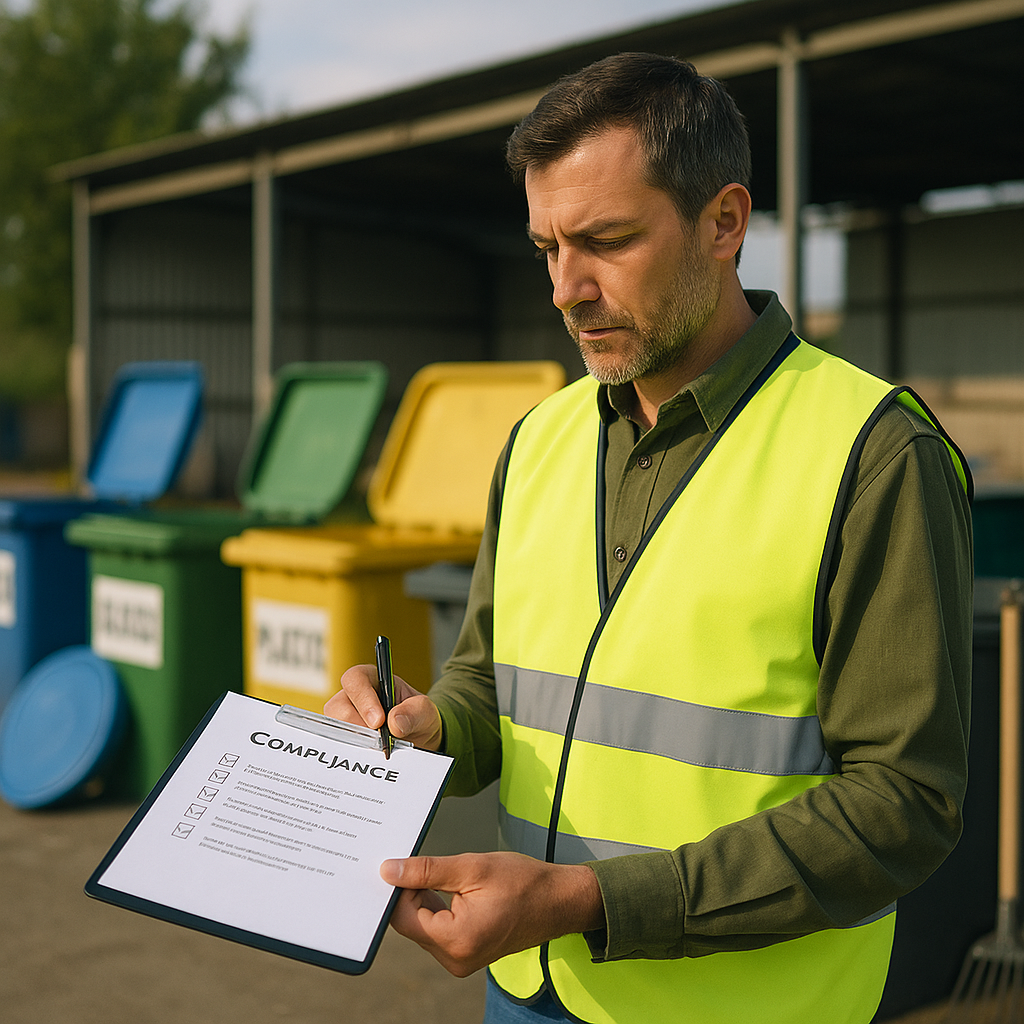5901 Botham Jean Blvd, Dallas, TX 75215
Environmental Compliance Services: Everything You Need to Know
September 11, 2025Environmental compliance services help organizations navigate the complex set of laws and regulations that govern business operations. These specialized services ensure companies reduce their environmental footprint while avoiding costly penalties. In the current regulatory environment, proper environmental management is essential for sustainable business operations.
These services encompass a wide range of activities crucial for regulatory adherence. From conducting thorough pre-purchase due diligence to performing environmental site assessments and implementing remediation strategies, compliance services address every aspect of environmental management. For businesses navigating regulatory requirements, these services provide the expertise needed to identify potential issues before they become costly problems.
The Environmental Protection Agency (EPA) reported that businesses paid over $1 billion in fines for environmental violations in 2022 alone. This significant figure highlights why property owners, facility managers, and corporate executives increasingly rely on environmental compliance expertise to safeguard their operations and reputation.
What are the Key Types of Environmental Compliance Services?

Environmental compliance services form the backbone of property due diligence and environmental risk management. Property owners, developers, and lenders rely on these assessments to identify potential environmental liabilities before purchase or development. Let’s explore the three primary types of Environmental Site Assessments (ESAs) that comprise these critical services.
Phase I Environmental Site Assessment
A Phase I ESA serves as the initial environmental risk assessment for property transactions. This preliminary evaluation is designed to identify recognized environmental concerns without invasive testing. The assessment includes reviewing historical property records, conducting site visits, interviews, and examining government databases.
When conducted prior to property purchase, a Phase I ESA satisfies the requirements for innocent landowner, contiguous landowner, or bona fide prospective purchaser liability protection under the EPA’s Comprehensive Environmental Response, Contamination, and Liability Act. This legal shield protects new property owners from responsibility for contamination that may be discovered later.
If the Phase I assessment yields no environmental concerns, property transactions typically proceed with confidence. However, when potential issues are identified, the assessment process advances to Phase II.
Phase II Environmental Site Assessment
The Phase II ESA moves beyond records review to determine factually whether contaminants exist on the property. This phase includes limited surface and subsurface testing of soil and water to verify the presence of hazardous materials. The scope varies based on Phase I findings, property history, and specific concerns identified in the initial assessment.
Key components of a Phase II assessment include soil sampling at various depths, groundwater testing, laboratory analysis for solvents and metals, and comparison of results against regulatory standards. Some assessments may also include inspections for asbestos, mold, radon, or lead-based paint in interior spaces.
When contamination is discovered during Phase II, regulatory authorities must be notified, and the process typically advances to the most comprehensive assessment level.
Phase III Environmental Site Assessment
The Phase III ESA, also known as a Contamination Assessment, provides the most thorough evaluation of environmental impacts. This assessment definitively determines both the horizontal and vertical extent of contamination through additional intrusive testing and develops a plan for addressing identified issues.
During this phase, environmental professionals may install groundwater monitoring wells, use soil vapor probes to assess vapor intrusion within buildings, and conduct indoor air quality testing. The assessment characterizes the size and source of contamination to inform remediation planning.
The Phase III assessment culminates in a detailed remediation design that outlines cleaning methods, technologies needed, and cost estimates for bringing the property into environmental compliance. Remediation may include soil treatment or removal, groundwater remediation, and vapor extraction until contaminant levels meet regulatory guidelines.
These progressive assessment levels enable property stakeholders to identify, quantify, and address environmental risks systematically. Each phase builds upon previous findings, creating a comprehensive understanding of property conditions and potential liabilities. For commercial transactions, lenders often require at least a Phase I assessment before financing property purchase, development, or renovation activities.
What Does Environmental Compliance Include?
Environmental compliance encompasses a broad range of services designed to help organizations meet regulatory requirements while minimizing their environmental impact. These services focus on four key areas: air quality management, land protection, water management, and wildlife preservation.
Air quality compliance ensures emissions meet regulatory standards to protect public health. Services in this area include air emission inventories, construction and operating permits, annual emission reporting, and air permit compliance monitoring. Organizations must follow strict guidelines regarding pollutant levels to avoid penalties and operational disruptions.
Land protection services address the impact of operations on soil and ecosystems. This includes proper waste disposal protocols, remediation of contaminated sites, and hazardous materials management. Companies generating hazardous waste must obtain EPA identification numbers and maintain detailed record-keeping systems for tracking and reporting purposes.
Water management compliance covers several critical areas. Stormwater permit applications and pollution prevention planning help organizations control runoff. NPDES wastewater permitting ensures proper treatment before discharge. Spill Prevention, Control, and Countermeasures (SPCC) planning protects water bodies from potential contamination due to oil storage and handling.
Wildlife preservation compliance ensures biodiversity is maintained by protecting natural habitats from industrial activities. These measures often require specialized assessments and ongoing monitoring to verify effectiveness.
Beyond these core areas, environmental compliance involves obtaining necessary permits, conducting regular monitoring, and implementing robust reporting systems. Many organizations also develop Environmental, Social, and Governance (ESG) frameworks that integrate sustainability into their broader business practices.
Implementing a comprehensive environmental compliance program typically involves environmental inspections, compliance audits, and specialized training for staff. These measures help organizations identify potential issues before they escalate into regulatory violations or environmental incidents.
For industrial facilities, compliance often includes specialized areas such as underground and aboveground storage tank management, drinking water treatment systems, and industrial pre-treatment operations. Each of these components requires specific expertise and attention to regulatory details.
Many organizations partner with environmental compliance consultants to navigate these complex requirements. These specialists provide guidance on regulatory frameworks, conduct environmental audits, and develop tailored compliance strategies for specific industries.
The scope of environmental compliance services continues to evolve as regulations become more stringent and public expectations for corporate environmental responsibility increase. Organizations that proactively address compliance not only avoid penalties but also enhance their sustainability profile and operational efficiency.
What are the Benefits of Environmental Compliance Services?

Environmental compliance services offer significant value to organizations beyond merely meeting regulations. These services provide a structured approach to navigating complex environmental guidelines while delivering tangible business benefits. Let’s explore key advantages that make environmental compliance services essential for forward-thinking companies.
Protection from Legal Liability
One major benefit of environmental compliance services is protection from legal issues. Environmental regulations are tightening, with the EPA increasing civil penalties by 3.2% in 2024, bringing maximum daily fines up to nearly $91,000 per violation. Compliance services help organizations identify potential issues before they escalate into costly legal problems.
Professional compliance services ensure all necessary permits are maintained, reports are filed on time, and operations remain within legal parameters. This preventative approach significantly reduces the risk of fines, penalties, and operational shutdowns that can impact a company’s financial health and productivity.
Proper documentation and record-keeping systems from compliance services also provide evidence of good-faith efforts to maintain compliance, which can be crucial if regulatory questions arise.
Substantial Cost Savings
While implementing environmental compliance services requires an initial investment, the long-term cost savings are significant. Businesses that proactively address compliance often avoid expensive emergency remediation, regulatory penalties, and litigation expenses, which can escalate quickly.
Compliance services often identify operational inefficiencies during assessments. Many organizations find opportunities to reduce waste, optimize resource use, and improve energy efficiency—all leading to lower operational costs. In some cases, businesses may qualify for tax incentives, grants, or subsidies designed to encourage sustainable practices.
A structured compliance program also reduces the administrative burden on internal teams, allowing staff to focus on core responsibilities rather than navigating complex regulations.
Enhanced Operational Efficiency
Environmental compliance services bring structure to organizational processes. When implementing compliance programs, businesses often discover outdated or inefficient workflows that can be streamlined or eliminated. Regular audits and assessments highlight areas for improvement that might otherwise go unnoticed.
Compliance services typically include developing standard operating procedures (SOPs) that bring consistency to environmental management activities. These standardized approaches reduce errors, minimize waste, and improve overall productivity. Advanced compliance systems can automate monitoring, reporting, and documentation tasks, further enhancing operational efficiency.
Better data management is another operational benefit. Compliance services implement systems to collect, organize, and analyze environmental data, providing valuable insights for business decision-making beyond regulatory requirements.
Reputation and Stakeholder Trust
Environmental responsibility is increasingly important to consumers, investors, and partners. Organizations committed to environmental compliance build stronger trust with stakeholders. A positive environmental record enhances brand reputation and can be a significant competitive advantage.
Investors now routinely consider environmental performance when making decisions. Many institutional investors incorporate environmental, social, and governance (ESG) criteria into strategies, meaning strong compliance can improve access to capital.
Communities respond positively to businesses prioritizing environmental protection, strengthening local relationships and social license to operate. This goodwill becomes valuable during expansion plans or operational changes.
Sustainable Business Practices
Environmental compliance services help organizations build sustainability into their core model. By addressing environmental impacts systematically, businesses can develop long-term approaches to resource conservation, waste reduction, and pollution prevention.
Compliance programs often identify opportunities for innovation in products and processes. These innovations can create new market opportunities and revenue streams focused on sustainability. Forward-thinking companies use compliance services to stay ahead of regulatory trends, positioning for success as standards evolve.
The structured approach from compliance services also helps businesses develop more resilient operations that can adapt to environmental challenges, resource constraints, and changing market expectations.
Competitive Market Advantage
As consumer preferences shift toward environmentally responsible products, strong compliance provides a market advantage. Businesses can leverage their performance in marketing and communications to differentiate from competitors.
Many large corporations require environmental compliance from suppliers and vendors. Organizations with robust programs gain access to opportunities that might otherwise be unavailable. The operational improvements from compliance often lead to higher-quality products, strengthening market position.
Additionally, businesses with strong environmental records typically find it easier to attract and retain top talent, particularly younger workers prioritizing environmental values when choosing employers.
Environmental compliance services transform regulatory requirements from potential business obstacles into strategic advantages. By protecting against liability, reducing costs, improving operations, building reputation, promoting sustainability, and creating competitive advantages, these services offer comprehensive value extending beyond basic regulatory adherence.
How to Choose an Environmental Compliance Services Provider

Selecting the right environmental compliance services provider is crucial for businesses aiming to effectively manage complex regulatory requirements. A qualified provider partners with you to handle environmental responsibilities, helping you avoid costly penalties and damage to your reputation.
When evaluating potential compliance partners, several key factors merit consideration to ensure you choose a provider capable of addressing your specific environmental challenges.
Industry Experience and Expertise
Look for providers with substantial experience in your specific industry. Because environmental regulations vary by sector, a provider familiar with your industry’s unique challenges will deliver more effective compliance solutions. Seek firms with at least 20 years of experience to ensure they possess a comprehensive understanding of regulatory environments and best practices.
Cross-disciplinary expertise is also important. Environmental compliance requires knowledge across multiple disciplines. The best providers maintain teams of environmental engineers, scientists, geologists, and other specialists to tackle complex compliance challenges.
Review case studies and client testimonials to verify their track record in solving problems like yours, to confirm their capabilities match your needs.
Geographical Reach and Jurisdictional Knowledge
Environmental regulations vary across local, state, and federal levels. If your operations occur in multiple locations, choose a provider with experience across all relevant jurisdictions to ensure consistent compliance management throughout your organization.
For businesses with national operations, selecting a firm with a nationwide presence offers significant advantages. Such providers can effectively serve all your properties, ensuring standardized compliance approaches while accommodating local regulatory nuances.
Providers should demonstrate a thorough understanding of regulations specific to your operating regions and stay current on evolving requirements in these areas.
Range of Services Offered
Comprehensive compliance support should include site assessments, permitting assistance, compliance plan development, and regular reporting. The provider should offer end-to-end solutions rather than fragmented services that might leave compliance gaps.
Look for capabilities in Phase I, II, and III Environmental Site Assessments, which determine environmental risks and contamination levels. Additional valuable services include remediation design, regulatory reporting, and implementation of compliance management systems.
A provider offering both routine compliance support and specialized services for unique challenges delivers greater long-term value.
Technical Capabilities and Resources
Providers must stay current with the latest technologies and techniques. Evaluate their access to advanced monitoring equipment, testing capabilities, and remediation technologies.
Digital compliance tools for tracking requirements, documenting activities, and generating reports greatly enhance efficiency. Ask potential providers about their technology solutions for streamlining compliance processes.
Ensure they employ qualified staff with relevant certifications and training in current compliance methodologies and standards.
Regulatory Knowledge and Updates
The environmental regulatory landscape changes frequently, so your provider must have systems to track regulatory updates and implement necessary changes to compliance programs.
Ask how they stay informed about emerging regulations and industry best practices. Providers should participate in industry associations, regulatory forums, and continuing education to maintain current knowledge.
The best providers offer proactive guidance concerning upcoming regulatory changes that might affect your operations, helping you prepare in advance.
Communication Approach and Responsiveness
Effective compliance partnerships require clear, consistent communication. Evaluate the provider’s communication systems and how they keep clients informed about compliance status and issues.
Inquire about their process for handling compliance emergencies or urgent regulatory matters. Responsive providers assign dedicated account managers who understand your business and compliance needs.
Regular compliance reports and updates should be part of their standard service offering, ensuring you maintain visibility into your environmental compliance status.
Cost Structure and Value
While cost matters, value is more important than finding the lowest price. Request detailed proposals outlining services, deliverables, and fee structures. This transparency helps avoid unforeseen costs later.
Consider the long-term value of comprehensive compliance support versus potential costs of non-compliance, including penalties, remediation, and reputational damage.
The most effective providers demonstrate how their services deliver tangible business value through risk reduction, operational improvements, and regulatory peace of mind.
Conclusion: The Importance of Environmental Compliance Services

Environmental compliance services are essential for organizations to manage complex regulatory requirements, protect themselves from liabilities, and contribute to environmental sustainability. The intricacy of environmental laws across different jurisdictions demands expertise that most organizations lack internally. Professional compliance services help businesses meet all regulatory requirements while optimizing their operations and building stakeholder trust.
As environmental regulations evolve in response to climate concerns and sustainability demands, these services will remain vital for responsible business practices. Companies that prioritize environmental compliance avoid costly penalties and reputational damage, positioning themselves as leaders in sustainable operations. For assistance with your recycling and environmental compliance needs, contact Okon Recycling at 214-717-4083.
